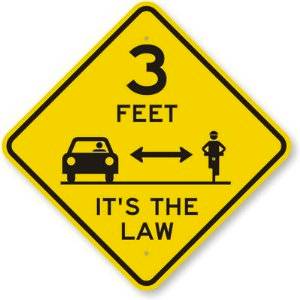 By now you’ve probably already heard that the Three Feet for Safety Act went into effect on Tuesday. The bill, which was finally signed by Governor Brown last year, was the result of significant work from groups like the California Bicycle Coalition and at one point our very own Bill Dullea, who testified on behalf of the legislation back in 2012.
By now you’ve probably already heard that the Three Feet for Safety Act went into effect on Tuesday. The bill, which was finally signed by Governor Brown last year, was the result of significant work from groups like the California Bicycle Coalition and at one point our very own Bill Dullea, who testified on behalf of the legislation back in 2012.
Prior versions of the legislation had been rejected by Governor Brown due to concerns “that the bill allowed cars to move to the left — over the double-yellow line, if necessary — to keep the three foot minimum distance from cyclists.” Although the new law stipulates drivers must stay three feet away when passing a cyclist, it does contain language saying that if a three foot cushion is not possible, drivers should slow down “and may only pass when doing so would not endanger the safety of the operator of the bicycle.”
Drivers caught failing to provide cyclists with three feet of space will face a fine of $35. And, in instances where a cyclist is injured the fines will increase to $220. As we’ve written before, the fines seem fairly trivial when you consider the relative vulnerability of a cyclist compared to a car. In California, 153 bicyclists were killed in collisions with motor vehicles in 2012. Those 153 deaths comprise five percent of the state’s traffic fatality total. A $35 fine seems like more of a nuisance than an actual punishment, but hopefully the new law will gain traction in reminding drivers to show a bit more courtesy toward cyclists regardless of monetary incentives.
As CalBike’s Dave Snyder said in an article from the Seattle Times, “It doesn’t really change what drivers are already supposed to do, but we think that by specifying the distance of three feet, drivers will be a little more patient and be safer in passing.”
Although the new law seems unlikely to curb the all too frequent animosity between motorists and cyclists, it does act as a step in the right direction, reminding motorists that they have a responsibility to share the road and be respectful of its other users. Similarly, cyclists are being reminded to ride with the flow of traffic, not against it, and to always stop at red lights and stop signs. Also, cyclists should wear reflective clothing when riding at night to ensure they’re visible to passing drivers.
It will be interesting to see how aggressive officers are in enforcing the new law. According to the California Highway Patrol, officers will have discretion in determining whether a three foot buffer was safely possible and whether the driver was putting a cyclist at unnecessary risk. Either way, it’s nice that the law we’ve been championing since 2011 is finally in effect.

